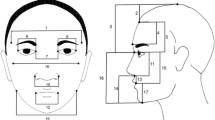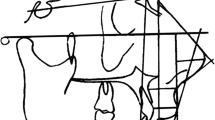Abstract
Objectives
The uvuloglossopharyngeal dimensions (UGPDs) are assumed to be affected by thalassemia major (TM). Because thalassemia intermedia (TI) is a milder form without need for blood transfusions, this study aimed to evaluate whether the UGPDs in thalassemic patients are equally affected by the two forms.
Methods
The study sample comprised 52 lateral cephalograms from thalassemic patients (31 TM; 21 TI) aged 12.98 ± 1.66 years. The control group comprised 25 lateral cephalograms from non-thalassemic subjects aged 13.64 ± 1.55 years with ANB > 3°. Linear measurements including tongue length (TGL), tongue height (TGH), soft palate length, uvula thickness (UT), superior airway space, middle airway space, inferior airway space, and mandibular plane to hyoid (MP–H) were recorded using AutoCAD 2007 software.
Results
Mean TGL, TGH, and MP–H in the thalassemic patient group were significantly smaller than those in the control group (all P < 0.05). Conversely, the mean UT was significantly greater than that in the control group (P < 0.001). The mean TGH, TGL, and MP–H in the control group were significantly greater than those in the TM and TI groups and the mean UT in the control group was significantly smaller than those in the TM and TI groups (all P < 0.05).
Conclusions
There were significant differences in some airway components (TGL, TGH, MP–H, UT) between the thalassemic patient group and the control group based on lateral cephalograms as a reliable tool. However, there were no significant differences in these measurements between TM and TI patients.

Similar content being viewed by others
References
Amini F, Borzabadi-Farahani A, Behnam-Roudsari G, Jafari A, Shahidinejad F. Assessment of the uvulo-glossopharyngeal dimensions in patients with β-thalassemia major. Sleep Breath. 2013;17:943–9.
Al-Wahadni A, Qudeimat MA, Al-Omari M. Dental arch morphological and dimensional characteristics in Jordanian children and young adults with β-thalassaemia major. Int J Paediatr Dent. 2005;15:98–104.
Sackey K. Hemolytic anemia: part 2. Pediatr Rev. 1999;20:204–8.
Abu Alhaija ES. Al-Wahadni AM, Al-Omari MA. Uvulo-glosso-pharyngeal dimensions in subjects with beta-thalassaemia major. Eur J Orthod. 2002;24:699–703.
Galanello R, Origa R. Beta-thalassemia. Orphanet J Rare Dis. 2010;5:11.
Shamshirsaz AA, Bekheirnia MR, Kamgar M, Pourzahedgilani N, Bouzari N, Habibzadeh M, et al. Metabolic and endocrinologic complications in beta-thalassemia major: a multicenter study in Tehran. BMC Endocr Disord. 2003;3:4.
Abu Alhaija ES. Hattab FN, Al-Omari MAO. Cephalometric measurements and facial deformities in subjects with β-thalassaemia major. Eur J Orthod. 2002;24:9–19.
Toman HA, Nasir A, Hassan R, Hassan R. Skeletal, dentoalveolar, and soft tissue cephalometric measurements of Malay transfusion-dependent thalassaemia patients. Eur J Orthod. 2011;33:700–4.
Amini F, Jafari AR, Eslamin L, Sharifzadeh S. A cephalometric study of craniofacial morphology of Iranian children with beta-thalassemia major. Orthod Craniofac Res. 2007;10:36–44.
Kollias I, Krogstad O. Adult craniofacial and pharyngeal changes–a longitudinal cephalometric study between 22 and 42 years of age. Part II: morphological uvulo-glossopharyngeal changes. Eur J Orthod. 1999;21:345–55.
Kapelushnik J, Shalev H, Schulman H, Moser A, Tamary H. Upper airway obstruction-related sleep apnea in a child with thalassemia intermedia. J Pediatr Hematol Oncol. 2001;23:525–6.
Tarasiuk A, Abdul-Hai A, Moser A, Freidman B, Tal A, Kapelushnik J. Sleep disruption and objective sleepiness in children with beta-thalassemia and congenital dyserythropoietic anemia. Arch Pediatr Adolesc Med. 2003;157:463–8.
Miltais F, Carrier G, Cormier Y, Series F. Cephalometric measurements in snorers, non-snorers, and patients with sleep apnoea. Thorax. 1991;46:419–23.
Miles PG, Vig PS, Weyant RJ, Forrest TD, Rockette HE Jr. Craniofacial structures and obstructive sleep apnea and meta-analysis of the literature. Am J Orthod Dentofac Orthop. 1996;109:163–72.
Sforza E, Bacon W, Weiss T, Thibault A, Petiau C, Krieger J. Upper airway collapsibility and cephalometric variables in patients with obstructive sleep apnea. Am J Respir Crit Care Med. 2000;161:347–52.
Schwartz AR, Schubert N, Rothman W, Godley F, Marsh B, Eisele D, et al. Effect of uvulopalatopharyngoplasty on upper airway collapsibility in obstructive sleep apnea syndrome. Am Rev Respir Dis. 1992;145:527–32.
Alves M Jr, Franzotti ES, Baratieri C, Nunes LK, Nojima LI, Ruellas AC. Evaluation of pharyngeal airway space amongst different skeletal patterns. Int J Oral Maxillofac Surg. 2012;41:814–9.
Abu Alhaija ES. Al-Khateeb SN. Uvulo-glosso-pharyngeal dimensions in different anteroposterior skeletal patterns. Angle Orthod. 2005;75:1012–8.
Solow B, Siersbaek-Nielsen S, Greve E. Airway adequacy, head posture, and craniofacial morphology. Am J Orthod. 1984;86:214–23.
Ceylan I, Oktay H. A study on the pharyngeal size in different skeletal patterns. Am J Orthod Dentofac Orthop. 1995;108:69–75.
Miles PG, O’Reilly M, Close J. The reliability of upper airway landmark identification. Aust Orthod J. 1995;14:3–6.
Riley RW, Powell NB. Maxillofacial surgery and obstructive sleep apnea syndrome. Otolaryngol Clin North Am. 1990;23:809–26.
Germec-Cakan D, Taner T, Akan S. Uvulo-glossopharyngeal dimensions in non-extraction, extraction with minimum anchorage, and extraction with maximum anchorage. Eur J Orthod. 2011;33:515–20.
Oktay H. A comparison of ANB, WITS, AF-BF, and APDI measurements. Am J Orthod Dentofac Orthop. 1991;99:122–8.
Chang HP. Assessment of anteroposterior jaw relationship. Am J Orthod Dentofac Orthop. 1987;92:117–22.
Handelman CS, Osborne G. Growth of the nasopharynx and adenoid development from one to eight years. Angle Orthod. 1976;46:243–59.
Linder-Aronson S, Leighton BC. A longitudinal study of the posterior nasopharyngeal wall between 3 and 16 years of age. Eur J Orthod. 1983;5:47–58.
Battagel JM, Johal A, Kotecha B. A cephalometric comparison of subjects with snoring and obstructive sleep apnea. Eur J Orthod. 2000;22:353–65.
Muto T, Yamazaki A, Takeda S. A cephalometric evaluation of the pharyngeal airway space in patients with mandibular retrognathia and prognathia, and normal subjects. Int J Oral Maxillofac Surg. 2008;37:228–31.
Zhong Z, Tang Z, Gao X, Zeng XL. A comparison study of upper airway among different skeletal craniofacial patterns in nonsnoring Chinese children. Angle Orthod. 2010;80:267–74.
Acknowledgments
The authors thank the Vice-Chancellery of Research, Shiraz University of Medical Sciences, for supporting this research (Grant no. 6978). This manuscript has been extracted from the DDS Thesis of Mr. Mehrshad Zareiyan, which was conducted under the supervision of Dr. Najmeh Movahhedian and the advisory of Dr. Leila Khojastepour and Dr. Hamidreza Pakshir. The authors would like to express their gratitude to Dr. Ehya Amalsaleh of the Dental Research Development Center, School of Dentistry, Shiraz University of Medical Sciences, for improving the use of English in the manuscript.
Author information
Authors and Affiliations
Corresponding author
Ethics declarations
Conflict of interest
Najmeh Movahhedian, Mehrshad Zareiyan, Hamidreza Pakshir, Mehrdad Vossoughi, Soheila Zareifar, and Leila Khojastepour declare that they have no conflict of interest.
Ethical statement
All procedures followed were in accordance with the ethical standards of the responsible committee on human experimentation (institutional and national) and with the Helsinki Declaration of 1964 and later versions. Informed consent was obtained from all patients for being included in the study.
Rights and permissions
About this article
Cite this article
Movahhedian, N., Zareiyan, M., Pakshir, H. et al. Evaluation of uvuloglossopharyngeal dimensions in patients with thalassemia intermedia and major. Oral Radiol 32, 167–172 (2016). https://doi.org/10.1007/s11282-015-0226-4
Received:
Accepted:
Published:
Issue Date:
DOI: https://doi.org/10.1007/s11282-015-0226-4




